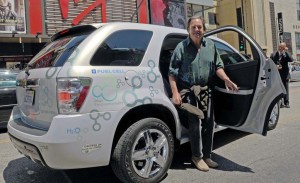
Actor Bo Bridges tries out a hydrogen-powered Chevrolet Equinox. The latest GM fuel cell "stack" is lighter, smaller and far less expensive.
Fuel cells. Remember them?
It wasn’t all that long ago that the headlines were filled with talk about hydrogen-based technology as the answer to the auto industry’s environmental problems. Over the last year or so, there’s been a shift to battery-powered drivetrain systems. But a numerous of technical improvements could put the fuel cell back in the running as the powertrain of choice for tomorrow’s automobile.
With Daimler AG promising to put the hydrogen-powered F-Cell into production, in the coming months, General Motors is hinting it could commercialize its own fuel cell technology as early as 2015. That’s a bit later than the troubled automaker once promised, but the news runs counter to those who expected GM to abandon its hydrogen program entirely in order to focus on battery-based vehicles, such as the Chevrolet Volt.
A release from General Motors hints at some of the reasons for its optimism – though TheDetroitBureau.com recently had a chance to see the new, 5th-generation GM fuel cell technology up close, where some additional details were disclosed.
The basic physics of the fuel cell date back to the mid-19th Century, though the technology only came into its own during the American Apollo mission, where it provided power for astronauts on the way to the moon. At its most basic, a fuel cell combines hydrogen and oxygen to produce a stream of current that can be used to power a vehicle’s motors – which is why some experts refer to it as a “refillable battery.” On the exhaust side, there’s nothing but clean water vapor.
The problems, however, have been numerous, starting with cost. Engineers need to take a device that cost millions, on a spacecraft, and bring it down to a few thousand dollars. For automotive applications, fuel cells also need to become smaller, lighter, more efficient and more robust.
The latest GM fuel cell “stack” measures half the size of the old system and comes in 220 pounds lighter; in all, it can now sit easily under the hood of a small car. The GM release also notes that it uses “less than half” the platinum and other precious metals of earlier fuel cell designs.
That’s an understatement. TheDetroitBureau.com has learned that the Gen-5 stack now requires less than 10 grams of platinum, notably less than is used in the typical catalytic converter of today. That translates into a huge saving in cash, but it also overcomes a big concern about earlier fuel cell designs; that they would require so much platinum there simply wouldn’t be enough to go around considering current global sources.
Meanwhile, other key changes are starting to bring the price of the technology more in line with conventional gasoline powertrains. Past fuel cell systems depended on low-volume, clean room manufacturing systems, and the many pieces that go into each stack had to be painstakingly hand-assembled. Much of the GM Gen-5 design, TDB has learned, can be stamped out much like any other piece of sheet metal, with the stack capable of high-volume robot assembly.
“The improvements the team has been able to achieve are remarkable,” said Charles Freese, executive director of GM Fuel Cell Activities. “Hardware mechanization has been dramatically simplified, which will help reduce cost, simplify manufacturing and improve durability.”
Why GM’s sudden decision to go public with the fuel cell update? Freese notes the automaker has invested $1.5 billion in its hydrogen program, so far, but “can no longer go it alone,” he says, adding, “As we approach a costly part of the program, we will require government and industry partnerships to install a hydrogen infrastructure and help create a customer pull for the products.”
GM is one of many makers participating in various test programs of fuel cell technology, notably in Southern California. But buoyed by the results of field testing, advanced programs are underway in Europe and Japan which could leave the U.S. lagging well behind – especially since the Obama Administration has shifted advanced energy research dollars away from hydrogen to battery projects.
A group of 13 energy companies is building an expansive hydrogen production and distribution infrastructure, in Japan. And just this month, an alliance between the German government and various energy providers and auto manufacturers announced an even more aggressive program, which will dot the country with 1,000 hydrogen refueling stations by the end of the coming decade. (The stations will also be equipped with battery chargers.)
“Failure to act will insure the U.S. cannot meet its long-term fuel efficiency and greenhouse gas reduction objectives,” Freese said. “We know what needs to be done. Now is the time to get started.”
GM officials aren’t saying what would happen without a U.S. infrastructure program, though they did suggest they could have hydrogen-powered product on the road by 2015.
Even with breakthroughs in fuel cell stack technology, and with the creation of a hydrogen infrastructure, experts caution that there is no guarantee the technology will ultimately replace the internal combustion engine — or prove superior to battery power. There are still a number of obstacles to overcome, notably a means to store enough hydrogen onboard a vehicle to give the driving range consumers demand.
